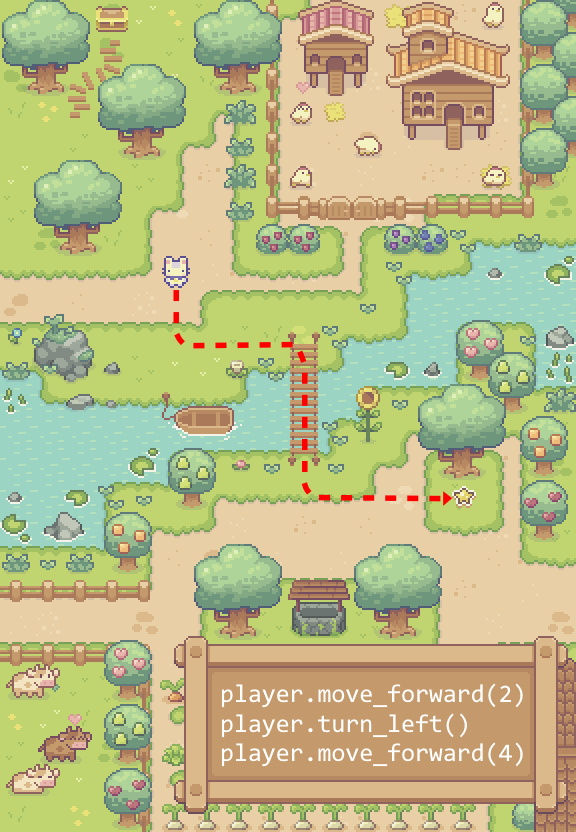Get started learning Python with DataCamp's free Intro to Python tutorial. Learn Data Science by completing interactive coding challenges and watching videos by expert instructors. Start Now!
This site is generously supported by DataCamp. DataCamp offers online interactive Python Tutorials for Data Science. Join 11 million other learners and get started learning Python for data science today!
Good news! You can save 25% off your Datacamp annual subscription with the code LEARNPYTHON23ALE25 - Click here to redeem your discount
Variables et Types
Python est complètement orienté objet, et n'est pas "typé statiquement". Vous n'avez pas besoin de déclarer des variables avant de les utiliser, ni de déclarer leur type. Chaque variable en Python est un objet.
Ce tutoriel couvrira quelques types de base de variables.
Numbers
Python prend en charge deux types de nombres - les entiers (nombres entiers) et les nombres à virgule flottante (décimaux). (Il prend également en charge les nombres complexes, qui ne seront pas expliqués dans ce tutoriel).
Pour définir un entier, utilisez la syntaxe suivante :
myint = 7
print(myint)
Pour définir un nombre à virgule flottante, vous pouvez utiliser l'une des notations suivantes :
myfloat = 7.0
print(myfloat)
myfloat = float(7)
print(myfloat)
Strings
Les chaînes de caractères sont définies soit avec un guillemet simple soit un guillemet double.
mystring = 'hello'
print(mystring)
mystring = "hello"
print(mystring)
La différence entre les deux est que l'utilisation de guillemets doubles facilite l'inclusion d'apostrophes (alors que cela terminerait la chaîne si des guillemets simples étaient utilisés).
mystring = "Don't worry about apostrophes"
print(mystring)
Il existe des variations supplémentaires pour définir des chaînes qui facilitent l'inclusion d'éléments tels que les retours chariot, les barres obliques inverses et les caractères Unicode. Ceux-ci dépassent le cadre de ce tutoriel, mais sont couverts dans la documentation Python.
Les opérateurs simples peuvent être exécutés sur les nombres et les chaînes :
one = 1
two = 2
three = one + two
print(three)
hello = "hello"
world = "world"
helloworld = hello + " " + world
print(helloworld)
Les affectations peuvent être effectuées sur plus d'une variable "simultanément" sur la même ligne comme ceci
a, b = 3, 4
print(a, b)
Le mélange d'opérateurs entre les nombres et les chaînes n'est pas pris en charge :
# Cela ne fonctionnera pas !
one = 1
two = 2
hello = "hello"
print(one + two + hello)
Exercice
Le but de cet exercice est de créer une chaîne de caractères, un entier et un nombre à virgule flottante. La chaîne de caractères doit être appelée mystring et doit contenir le mot "hello". Le nombre à virgule flottante doit être appelé myfloat et doit contenir le nombre 10.0, et l'entier doit être appelé myint et doit contenir le nombre 20.
# change this code
mystring = None
myfloat = None
myint = None
# testing code
if mystring == "hello":
print("String: %s" % mystring)
if isinstance(myfloat, float) and myfloat == 10.0:
print("Float: %f" % myfloat)
if isinstance(myint, int) and myint == 20:
print("Integer: %d" % myint)
# change this code
mystring = "hello"
myfloat = 10.0
myint = 20
# testing code
if mystring == "hello":
print("String: %s" % mystring)
if isinstance(myfloat, float) and myfloat == 10.0:
print("Float: %f" % myfloat)
if isinstance(myint, int) and myint == 20:
print("Integer: %d" % myint)
test_object('mystring', incorrect_msg="Don't forget to change `mystring` to the correct value from the exercise description.")
test_object('myfloat', incorrect_msg="Don't forget to change `myfloat` to the correct value from the exercise description.")
test_object('myint', incorrect_msg="Don't forget to change `myint` to the correct value from the exercise description.")
test_output_contains("String: hello",no_output_msg= "Make sure your string matches exactly to the exercise desciption.")
test_output_contains("Float: 10.000000",no_output_msg= "Make sure your float matches exactly to the exercise desciption.")
test_output_contains("Integer: 20",no_output_msg= "Make sure your integer matches exactly to the exercise desciption.")
success_msg("Great job!")
This site is generously supported by DataCamp. DataCamp offers online interactive Python Tutorials for Data Science. Join over a million other learners and get started learning Python for data science today!




